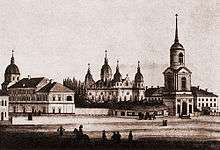Brotherhoods (confraternities)


Brotherhoods (Ukrainian: братства, bratstva; literally, "fraternities") were the secular unions of Orthodox citizens affiliated with individual churches[1] in the cities throughout Ruthenian part of the Polish–Lithuanian Commonwealth such as Lviv, Wilno, Lutsk, Vitebsk, Minsk, and Kiev. They adapted the structure of the Western medieval confraternities and trade guilds.[1]
The origin of brotherhoods could be traced to the medieval Kievan Rus as bratchyny that were mention in the Hypatian Chronicle of 1159.[1] The more modern Orthodox brotherhoods, first documented in 1463 (Lviv Dormition Brotherhood), were consolidated in the aftermath of the Union of Brest (1596) in order to oppose a rise in the Roman Catholic proselytism, Jesuit expansionism and general Polonization.[1] The brotherhoods attempted to stem the state-supported Catholic missionary activities by publishing Cyrillic books and financing a net of brotherhood schools which offered education in the Ruthenian language.[2] The famous Kiev Mohyla Academy grew out of one such school under the umbrella of the Brotherhood Monastery in Kiev. The Dormition Church, Lviv was financed by the brotherhood of the same name; its members also supported the Cossack risings in the east of Ukraine. The powerful Ostrogski family provided political support for their activities.
The activity of the Orthodox fraternities helped preserve the national culture of Ukraine and Belarus throughout the Counter-Reformation era.[3] Most were closed in the course of the 18th century when Catholic proselytism was on the wane. Some were revived in the late 19th century in order to stem "atheist propaganda" of the Nihilists.[2] The Brotherhood of Saints Cyril and Methodius promoted national awareness, helping the Ukrainians of Imperial Russia discover their national identity. The Ostrog bratstvo was reinstituted by Countess Bludova, an ardent admirer of the Ostrogski family.
See also
References
- 1 2 3 4 Brotherhoods at the Encyclopedia of Ukraine
- 1 2 Russian Humanitarian Encyclopaedia
- ↑ Orest Subtelny. Ukraine: A History. 3rd ed. University of Toronto Press, 2000. Pages 97-99.